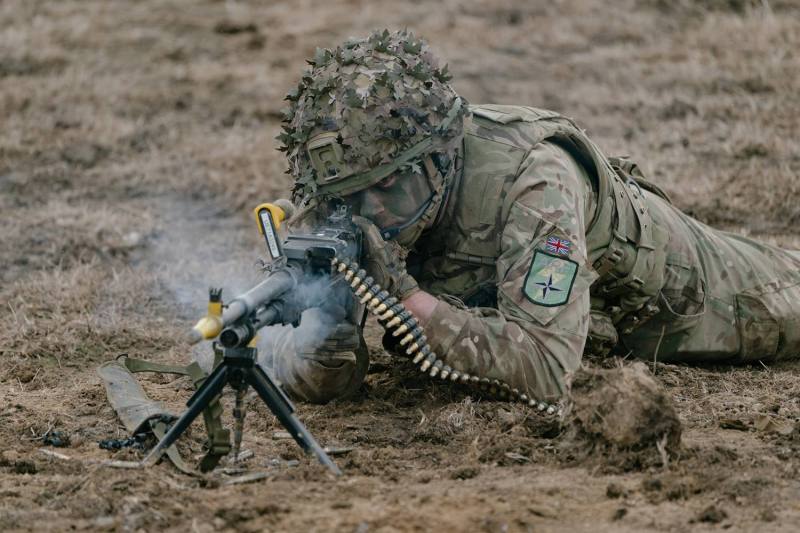What It Means for Europe to Go It Alone

What It Means for Europe to Go It Alone
Europe and NATO are facing an existential crisis as the Trump administration aims a wrecking ball at trans-Atlantic relations.
A British soldier shoots his gun during an exercise in Smardan, Romania, on Feb. 17. Andrei Pungovschi/Getty Images
Welcome back to Foreign Policy’s Situation Report, where we’re still waiting for the dust to settle after all the drama at the Munich Security Conference.
Alright, here’s what’s on tap for the day: Europe considers a future without the U.S. military, U.S. President Donald Trump picks a fight with Ukrainian President Volodymyr Zelensky, and U.S. Defense Secretary Pete Hegseth moves to revamp the Pentagon’s budget.
Welcome back to Foreign Policy’s Situation Report, where we’re still waiting for the dust to settle after all the drama at the Munich Security Conference.
Alright, here’s what’s on tap for the day: Europe considers a future without the U.S. military, U.S. President Donald Trump picks a fight with Ukrainian President Volodymyr Zelensky, and U.S. Defense Secretary Pete Hegseth moves to revamp the Pentagon’s budget.
Europe Is ‘Looking Into the Abyss’
Europe and NATO are facing an existential crisis as the Trump administration aims a wrecking ball at trans-Atlantic relations, forcing historic allies to ask tough questions about their defensive capabilities. In recent days, the White House effectively signaled to Europe that it can no longer count on Washington to always have its back as the Trump administration moves to thaw relations with Moscow and parrots Russian disinformation about the war in Ukraine.
There are now rising concerns in Europe that Trump could move to pull U.S. troops from countries across the continent—a prospect alluded to by U.S. Defense Secretary Pete Hegseth in Warsaw last Friday. “You can’t make an assumption that America’s presence will last forever,” Hegseth said.
This all comes atop serious doubts that the Trump administration would honor Article 5 of the alliance’s charter and come to the defense of NATO members in the event of an attack. On Thursday, U.S. National Security Advisor Mike Waltz told reporters at the White House, “We fully support the Article 5 commitment, but it’s time for our European allies to step up.” Trump floated pulling the United States from NATO during his first term—a proposal that continues to be a source of concern in Europe today, despite questions over whether he could legally do so without involving Congress.
“This is an existential moment and it’s a moment where Europe has to stand up,” German Foreign Minister Annalena Baerbock said on Saturday. But is Europe up to the task?
Can Europe hold its own? Approximately 100,000 U.S. troops are stationed across Europe, with the bulk of the presence (around 35,000 troops) in Germany, according to U.S. Defense Department statistics. This is considered to be a major deterrent against Russia. If the United States were to suddenly pull these troops, experts say that Europe would struggle to defend itself in the event of an attack.
“Europeans are already one foot into a scenario where there won’t even be U.S. forces in Europe. It’ll be just them. And I can tell you right now, they don’t have the mass, they don’t have the depth, the bench to be able to do all the things that U.S. forces are doing there currently,” Jim Townsend, who served as U.S. deputy assistant secretary of defense for European and NATO policy from 2009 to 2018, told SitRep.
Europe is now “looking into the abyss,” Townsend said, and he warned that the “European allies are not in a very good place to just flip a switch” and take over U.S. duties in Europe.
Tardy to the party. “If Europe had been given a heads-up 10 years ago and did what they needed to get the numbers of forces and get the equipment, they’d be able to take on the Russians,” said Townsend, who is now an adjunct senior fellow at the Center for a New American Security’s Transatlantic Security Program. “The Russians aren’t 10 feet tall,” Townsend added, but they’ve become “battle-hardened” and “more modern” in recent years.
Yet some, including Europeans themselves, have pointed out that the push from the United States for allies to spend more on defense isn’t new, and they are questioning why European leaders were so slow to get the message and act.
As we reported last week, when SitRep asked NATO Secretary-General Mark Rutte whether he’d care to put a timeline on his call for NATO members to hit a new spending target of 3 percent of GDP, Rutte said he hoped such details would be sorted out by the NATO summit in June. He then continued: “We cannot have a repeat of 2014 [the last time NATO set a spending target], where we set 2 percent and then nothing happened till Trump became president, and then all of a sudden we saw Europeans and Canadians spending more.”
Or, as one former Eastern European foreign minister told our friends at Politico, “We had years and years to strengthen our military resolve and prepare for a new era with the U.S., and we squandered them.”
What does Europe need to do? NATO has a relatively modest direct budget of around $4.8 billion that all members contribute to funding, with the United States and Germany leading the pack by contributing about 16 percent of the alliance’s annual budget each. But individual spending by each country is considered more important in terms of the alliance’s overall strength.
Trump is pushing allies to spend 5 percent of their GDP on defense spending, far higher than NATO’s previous goal of 2 percent of GDP per member by 2024. The United States spends around 3.4 percent of its GDP on defense, but it accounts for more than 50 percent of the alliance’s GDP overall. As of last year, 23 out of NATO’s 32 members have met the 2 percent goal. NATO also set a goal for members to spend 20 percent of defense expenditures on major new military equipment, a benchmark that only two allies—Canada and Belgium—are noncompliant with.
Many European countries are on board with taking more responsibility for the continent’s defense. “We have no luxury anymore to sit in the back seat and think that somebody’s driving the car. No, we need to drive the car,” Estonian Foreign Minister Margus Tsahkna told SitRep at the Munich Security Conference. Tsahkna said that NATO countries reaching Trump’s 5 percent target depends on “how realistically we actually understand the threat from Russia,” but he said he believes that Estonia and other Baltic states are likely to reach that level of spending in the coming years.
British Prime Minister Keir Starmer said on Monday that Europe was facing a “generational challenge” from a security standpoint, urging the entire continent to spend more on defense.
But just increasing spending alone may not be sufficient to solve the problem, analysts warn. European allies also need to be strategic about how and where they spend that money.
It’s good that Europe is acknowledging the need to spend more on defense, but in many ways it’s “too late,” and U.S. allies there have operated under “wishful thinking” and delayed making changes for too long, Townsend said. NATO has put together solid regional defense plans, he added, but beyond that, Europe needs to “quickly” assess where the gaps would be “in the line against Russia” if the United States were to leave, and then determine which countries could fill the void.
“What Trump has done, frankly, is he’s pulled the bandage off, which was very painful,” Townsend said, adding that the U.S. president has exposed the ways in which “the Europeans have atrophied over time.”
Let’s Get Personnel
The latest Trump appointees confirmed by the Senate:
- Howard Lutnick as commerce secretary
- Kash Patel as FBI director
GOP Sen. Mitch McConnell of Kentucky, the 83-year-old former Senate majority leader who has been one of the most influential politicians in Washington for years, announced on Thursday that he will not seek reelection.
On the Button
What should be high on your radar, if it isn’t already.
Trump calls Zelensky a ‘dictator.’ Trump has turned on Ukrainian President Volodymyr Zelensky in recent days, falsely blaming him for Russia’s invasion of Ukraine and calling him a “dictator without elections.” Zelensky was democratically elected, but elections were suspended in Ukraine after martial law was declared following Russia’s 2022 invasion. It’s not uncommon for countries to postpone elections during wartime—the United Kingdom did so during World War II—and experts say it would be impractical for Ukraine to hold them with fighting ongoing.
Trump’s criticism of Zelensky comes as the U.S. president pushes for a swift end to the war. His administration has begun talks with Russia without involving Kyiv. In the process, Trump has opened the door for major concessions to the Kremlin, including blocking Ukraine from joining NATO and seeing Kyiv cede territory occupied by Russian forces. The Trump administration also says that Europe alone should be responsible for Ukraine’s security.
Meanwhile, Zelensky said this week that Trump is “surrounded by disinformation,” in a clear sign that the Ukrainian leader is fed up with his U.S. counterpart’s rhetorical attacks. As relations continue to sour, a planned news conference between Trump’s Ukraine envoy and Zelensky was canceled on Thursday—a decision reportedly made by the U.S. side.
Hegseth’s DoD makeover. The defense secretary has ordered Pentagon officials to come up with a plan for slashing $50 billion from the department’s budget in fiscal year 2026, with the goal of redirecting those funds toward Trump’s “America First” priorities. Initiatives that could potentially be slashed include “so-called ‘climate change’ and other woke programs, as well as excessive bureaucracy,” according to a statement from acting Deputy Defense Secretary Robert Salesses on Wednesday.
Meanwhile, Hegseth is reportedly contemplating firing a number of generals and senior officers in order to replace them with others more closely aligned with Trump’s agenda. The dismissals could occur as early as this week, NBC News reported.
Trade talks. Along with the threat of U.S. military abandonment, Europe also still faces the threat of U.S. reciprocal tariffs announced by Trump last week. Maros Sefcovic, the European Union commissioner for trade and economic security, is in Washington this week to head off the latter, spending around four hours yesterday with the U.S. Commerce Secretary Howard Lutnick, U.S. Trade Representative nominee Jamieson Greer, and National Economic Council Director Kevin Hassett.
Sefcovic said that he sought “constructive dialogue to avoid the unnecessary pain of measures and countermeasures,” but he stressed repeatedly that Europe will ultimately protect its own interests.
“We’ve said very clearly that if these import duties are aimed at us in an unfair and arbitrary way, then we will react firmly and resolutely,” he told reporters in a briefing Thursday morning. “I still believe that we can avoid this … and therefore I would prefer to talk.”
Snapshot
Ukrainian President Volodymyr Zelensky gives a press conference in Kyiv on Feb. 19.Tetiana Dzhafarova/AFP via Getty Images
Put On Your Radar
Thursday Feb. 20 through Friday Feb. 21: G-20 foreign ministers meet in Johannesburg, South Africa.
Sunday, Feb. 23: Germany is set to hold early parliamentary elections.
Monday, Feb. 24: The three-year anniversary of Russia’s invasion of Ukraine.
Quote of the Week
“I’m glad you guys liked it. Not everybody liked it. You guys liked it.”
—U.S. Vice President J.D. Vance speaking at the Conservative Political Action Conference on Thursday, as the audience applauded interviewer Mercedes Schlapp’s comment praising his speech at the Munich Security Conference.
This Week’s Most Read
- Vance Leaves Europe Gobsmacked by Rishi Iyengar and Keith Johnson
- It’s Time for Europe to Do the Unthinkable by Kishore Mahbubani
- DOGE Is Hacking America by Bruce Schneier and Davi Ottenheimer
Whiskey Tango Foxtrot
A humpback whale recently swallowed a kayaker off Chile’s Patagonian coast, but it apparently found the man unpalatable and fortunately decided to spit him out. The entire ordeal was captured on video. The man, Adrián Simancas, 23, said that he initially wondered if he’d been swallowed by an “orca or sea monster.”
“I closed my eyes, and when I opened them again, I realised I was inside the whale’s mouth,” Simancas told BBC News. He described the texture of the whale’s mouth as “slimy.”
John Haltiwanger is a reporter at Foreign Policy. X: @jchaltiwanger
Rishi Iyengar is a reporter at Foreign Policy. X: @Iyengarish
More from Foreign Policy
-

A security guard stands at the entrance to the U.S. Agency for International Development (USAID) headquarters on Feb. 3. DOGE Is Hacking America
The U.S. government has experienced what may be the most consequential security breach in its history.
-

A man with a beard in a suit and tie speaks behind a teleprompter. The logo for MSC is behind him. Vance Leaves Europe Gobsmacked
U.S. Vice President J.D. Vance delivered a rebuke on immigration and alleged censorship to a shocked Munich Security Conference.
-

A Palestinian girl carries a child through the rubble of houses destroyed by Israeli bombardment in Gaza City on March 3, 2024. Why Is the World So Polarized on Gaza?
The answer might be linked to race and colonization, explains author Pankaj Mishra, speaking on FP Live.
-

An attendee dressed like Uncle Sam waits for Donald Trump to arrive for a campaign rally at the Mosack Group warehouse on September 25, 2024 in Mint Hill, North Carolina. America Is Its Own Worst Enemy
It’s not unprecedented for a powerful country to simply shoot itself in the foot.









Join the Conversation
Commenting on this and other recent articles is just one benefit of a Foreign Policy subscription.
Already a subscriber?
.
Subscribe
Subscribe
View Comments
Join the Conversation
Join the conversation on this and other recent Foreign Policy articles when you subscribe now.
Subscribe
Subscribe
Not your account?
View Comments
Join the Conversation
Please follow our comment guidelines, stay on topic, and be civil, courteous, and respectful of others’ beliefs.
Change your username |
Log out
Change your username:
CANCEL
Confirm your username to get started.
The default username below has been generated using the first name and last initial on your FP subscriber account. Usernames may be updated at any time and must not contain inappropriate or offensive language.